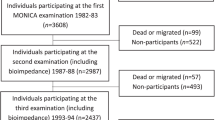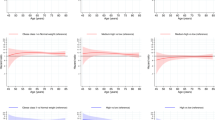Abstract
After the age of 60 y, body weight on average tends to decrease. The contribution of fat mass to this weight loss is relatively small, but fat tends to be redistributed with advancing age toward more abdominal (particularly visceral) fat. Anthropometric data are relatively poor indicators of these aging processes. This may be one of the explanations why the relationship between high body mass index and mortality is less pronounced in older than in younger people. Reduced lipolysis in the visceral fat depot with aging is among potential explanations why increased visceral fat seems to be less harmful in elderly subjects compared to young adults. Even though the relative contribution of increased fat mass to mortality may be less pronounced in elderly people, the impact on disability and functional limitations is found to be important from both a clinical and a public health point of view. At the other end of the scale studies have shown that low body mass index and weight loss in the elderly are both strong predictors of subsequent mortality. This cannot be explained by effects of smoking and early mortality after baseline. There are only few systematic studies comparing the predictive validity of different anthropometric data for mortality. One recent prospective study showed that a high waist circumference (in non-smoking men) may be a better predictor of all-cause mortality than high body mass index and waist/hip ratio. Low BMI was a better predictor of mortality than low waist circumference. In conclusion changes in body composition and fat distribution with aging are poorly captured by standard anthropometric data. Low lean body mass is probably better reflected by low BMI, whereas increased (abdominal) fatness is better reflected by increased waist circumference.
European Journal of Clinical Nutrition (2000) 54, Suppl 3, S33–S39
This is a preview of subscription content, access via your institution
Access options
Subscribe to this journal
Receive 12 print issues and online access
$259.00 per year
only $21.58 per issue
Buy this article
- Purchase on Springer Link
- Instant access to full article PDF
Prices may be subject to local taxes which are calculated during checkout
Similar content being viewed by others
Author information
Authors and Affiliations
Corresponding author
Rights and permissions
About this article
Cite this article
Seidell, J., Visscher, T. Body weight and weight change and their health implications for the elderly. Eur J Clin Nutr 54 (Suppl 3), S33–S39 (2000). https://doi.org/10.1038/sj.ejcn.1601023
Published:
Issue Date:
DOI: https://doi.org/10.1038/sj.ejcn.1601023
Keywords
This article is cited by
-
Association between physical activity and longitudinal change in body mass index in middle-aged and older adults
BMC Public Health (2023)
-
Validation of original, alternative, and updated alternative fistula risk scores after open and minimally invasive pancreatoduodenectomy in an Asian patient cohort
Surgical Endoscopy (2023)
-
Body mass index trend and variability in rheumatoid arthritis
Clinical Rheumatology (2022)
-
Functional fitness norms and trends of community-dwelling older adults in urban China
Scientific Reports (2021)
-
Total Energy Expenditure and Functional Status in Older Adults: A Doubly Labelled Water Study
The Journal of nutrition, health and aging (2021)



